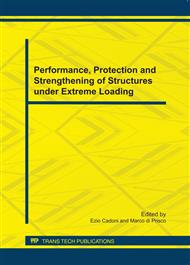[1]
Scawthorn C., Eidinger J.M., Schiff A.J. (2005). Fire following earthquake. ASCE Publications. ISBN: 0784407398.
Google Scholar
[2]
Wellington Lifelines Group (2002). Fire Following Earthquake: identifying key issues for New Zealand.
Google Scholar
[3]
Faggiano B., Esposto M., Mazzolani F.M. (2008). Risk assessment of steel structures under fire, 14th World Conference on Earthquake Engineering, Beijing, PR of China, paper No. S19-015.
Google Scholar
[4]
Chen S., Lee G.C., Shinozuka M. (2004). Hazard Mitigation for Earthquake and Subsequent Fire. ANCER Annual Meeting, Honolulu, Hawaii.
Google Scholar
[5]
Johann M.A., Albano L.D., Fitzgerald R.W., Meacham B.J. (2006). Performance-based structural fire safety. ASCE Journal of Performance of Constructed Facilities, Vol. 20, No. 1, 45-53.
DOI: 10.1061/(asce)0887-3828(2006)20:1(45)
Google Scholar
[6]
Bennetts I.D., Thomas I.R. (2002). Design of steel structures under fire conditions. Progress in Structural Engineering Materials, Vol. 4, 6-17.
Google Scholar
[7]
Britton N.R., Clark G.C. (1999). Emergency Management and Insurance: Toward a Collaborate Approach.Neil R Britton (Ed.), The Changing Risk Landscape. Sydney. Southwood Press, 219-238.
Google Scholar
[8]
Della Corte G., Landolfo R., Mazzolani F.M. (2003). Post-earthquake fire resistance of moment-resisting steel frames. Fire Safety Journal, 38, 593-612, Elsevier Ltd.
DOI: 10.1016/s0379-7112(03)00047-x
Google Scholar
[9]
Faggiano B., De Gregorio D., Mazzolani F.M., (2010). Assessment of the robustness of structures subjected to fire following earthquake through a Performance-Based approach. Intern. Conf. COST Action C26 Urban habitat constructions under catastrophic events, Naples, Italy. ISBN 978-0-415-60685-1. pp: 207-212.
DOI: 10.1201/b10559-22
Google Scholar
[11]
Scawthorn C. (1986). Simulation modelling of fire following earthquake. Proc. Third US National Conference on Earthquake Engineering, Charleston, August.
Google Scholar
[12]
Scawthorn C. (1987). Fire following earthquake: estimates of the conflagration risk to insured property in greater Los Angeles and San Francisco. All-Industry Research Advisory Council.
Google Scholar
[13]
Scawthorn C., Iemura H., Yamada Y. (1991). Model for urban post-earthquake fire hazard. Disaster: The International Journal of Disaster Studies and Practice, London, Vol. 5, No. 2.
DOI: 10.1111/j.1467-7717.1981.tb01095.x
Google Scholar
[14]
FEMA (Federal Emergency Management Agency, 1999). HAZUS Earthquake Loss Estimation Methodology, Technical Manual, U.S.A.
Google Scholar
[15]
Williamson R.B., Groner R. (2000). Ignition of fires following earthquakes associated with natural gas and electric distribution systems. Pacific Earthquake Engineering Research Centre, University of California.
Google Scholar
[16]
Cousins W.J., Dowrick D.J, Sritharan S. (1991). Fire following earthquake, Proc. Institution of Fire Engineers Conference, New Plymouth.
Google Scholar
[17]
Cousins W.J., Thomas G.C., Heron D.W., Mazzoni S., Lloydd D. (2002). Modelling the spread of post-earthquake fire in Wellington City, Proc. of the 2002 Technical Conf. and AGM, New Zealand Society for Earthquake Engineering, Napier.
DOI: 10.1193/1.4000002
Google Scholar
[18]
Botting R. (1998). The impact of post-earthquake fire on the built urban environment, Fire engineering research report 98/1, University of Canterbury, New Zealand.
Google Scholar
[19]
Standards Australia and Standards New Zealand (1999). Risk Management AS/NZS4360, Sydney and Wellington.
Google Scholar


